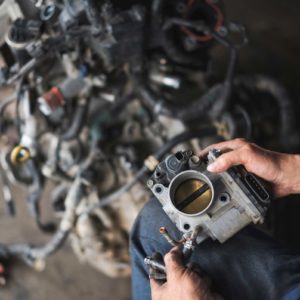Newer vehicles are equipped with an electronic throttle control (ETC) or throttle actuator control (TAC) system. The system replaces the mechanical linkage between the accelerator pedal and throttle body with an electric actuator motor to control the throttle valve opening.
The ETC system has a TAC module that relays the information to the powertrain control module (PCM) over a data network. If the PCM is unable to pick up a signal or receives an unusual signal from the TAC module, on-board diagnostics (OBD) will log a P2108 fault code.
What Does the P2108 Code Mean?
Diagnostic trouble code (DTC) P2108 stands for “Throttle Actuator Control Module Performance.”
When the driver steps on the accelerator pedal, the electrical resistance in the accelerator pedal position (APP) sensors changes. These modifications indicate a shift in pedal position, which lets the PCM control the throttle opening.

In some cases, it’s the TAC module that operates the throttle blade and communicates with the PCM via a data network. If a problem is detected with the TAC module, the PCM will log a P2108 code. It might also send the vehicle into “limp mode” or “fail-safe mode” to limit engine speed.
Note: The definition of code P2108 might be different depending on the vehicle manufacturer. Consult the appropriate repair manual or repair database for the exact code definition.
What are the Common Causes of the P2108 Code?
- Faulty sensor (manifold absolute pressure sensor, APP sensor, TP sensor, etc.)
- PCM failure
- Wiring issues
- Faulty throttle actuator

What are the Common Symptoms of the P2108 Code?
- Engine won’t start
- Vehicle stuck in “limp mode”
- Illuminated check engine light
- Increased fuel consumption
How to Diagnose the P2108 Code
DTC P2108 can be logged in vehicles with an OBD-II system. However, keep in mind that the steps for diagnosis and repair can differ depending on the vehicle’s specifications. Diagnosing trouble codes also involves using tools that can be confusing for those who are not well-versed in automotive repair.
If you’re not confident in your DIY skills yet, it might be best to have a trained professional do the job for you instead. Otherwise, you can go ahead and do it yourself.
How to Fix the P2108 Code
Without the right tools and technical knowledge, attempting to fix a DTC P2108 can be confusing and might even lead to more repairs if done incorrectly. Under these circumstances, it’s best to leave the job to the pros to ensure that all steps and protocols are followed properly.
But if you think you have what it takes to fix this trouble code, make sure you have the right equipment and information before proceeding. Keep in mind that there is no such thing as a magic bullet that can fix all DTCs for all types of vehicles.
You might want to check out guides like those from Chilton or an ALLDATA subscription to get vehicle-specific repair information before working on your daily driver.
Any information provided on this Website is for informational purposes only and is not intended to replace consultation with a professional mechanic. The accuracy and timeliness of the information may change from the time of publication.


















